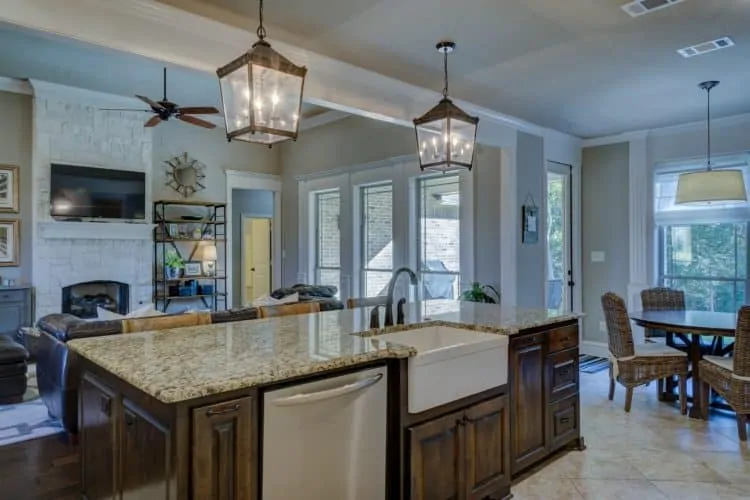
- By Remodel Works
- In Blog
Aging in Place Remodeling Tips
Aging in Place Remodeling Tips
You’ve invested a lot of time and money into your home over the years – not to mention all the memories you’ve created there – so it’s no surprise that you want to stay there for as long as possible. The good news is, with a sound aging in place plan, you’ll be able to stay in your home for years into the future. Here are some of our favorite aging in place remodeling tips for homeowners who want to age in their home.
Start With the Bathroom
Because of its hard and slippery surfaces, almost 235,000 people visit the emergency room each year with injuries suffered while bathing, showering, or using the facilities (ConsumerReports.org). This makes the bathroom one of the first rooms that homeowners start with when they start the journey of aging-in-place remodeling.
However, there are numerous ways to practice aging in place remodeling in your bathroom without making it look like a hospital. For example, enlarging the shower is an easy change to make in the middle stages of life. You can also lower thresholds to ease entry, which will also give you the visual benefit of a more open space. Down the road, a curbless shower will prove to be a sound aging-in-place design.
You can also make other in-shower modifications to start prepping for an aging-in-place lifestyle without sacrificing aesthetic. For example, adding shower seats, upgrading lighting, and hanging shelves or ridges will all assist with ease of shower use down the road.
Another smart and safe upgrade you can make within your bathroom is modifying the floors. Water and slick tile are a bad combination, so switching to slip-resistant tile or vinyl is a safer move for the long-term. Seek out extra textured tile, or smaller tiles embedded in grout to create more friction and “grip” for safety.
Whether in your bathroom, kitchen or garage, sinks are another home element that are prime for aging in place remodeling. Dual-height countertops are a good idea for families with small children, and into the future, can benefit older home residents. If you choose to remodel your sinks, make sure they are wall-mounted, leaving space underneath for someone seated.
Other sink considerations should be faucets (lever handles are easiest to use), and installing full-length mirrors over countertop or medicine cabinet mirrors, which provide easier visibility for seated residents and wheelchairs.
Practice Aging in Place Kitchen Design
The kitchen is another key room of the house that should be considered for aging in place remodeling. First of all, make sure your kitchen is on the main floor of your home. If not, you should consider remodeling to add one, as food preparation is an activity of daily living.
Another thing to revisit in aging in place kitchens is the general layout and use of clearance space. The standard clearance between cabinets, walls, and appliances should be 36 inches, which is enough room to comfortably pass in a walkway and have access to drawers and doors.
If you are willing to rearrange your kitchen to add more clearance space, you should also use that time to make other layout modifications, such as moving the sink close to the stove. This is a great idea because, as we age, it’s harder on our arms and backs to carry big pots full of water or food to and from the cooktop.
With this advice in mind, you may be tempted to put your sink right next to your stove, but be sure to leave workspace in between. If your sink and stove are so close together that you don’t have anywhere to rest a hot pot or pan, you may be in more trouble than you started out with. In many cases, placing the sink across from the stove is a close enough distance.
Another expert kitchen remodel tip is to make the gradual switch to drawers instead of cabinets for storing all of your kitchen items. Drawers are an excellent choice for aging in place kitchen design because they display all flatware and utensils at once, which allows for easy grabbing. No need to get on your knees to peer into floor level cabinets, or use a step ladder to grab out of top-level cabinets.
Revisit Doors and Entryways
As you work on installing aging-in-place kitchens, bathrooms, and everything else, the last thing you want to realize is that your doors – your conduit between all those rooms you worked so hard to remodel – are not aging-in-place friendly.
Doors and doorways are often overlooked when it comes to revisiting the design of your house to make it more accessible. Over the years, you may find that your doors aren’t wide enough for access, they are hard to open, or swinging prevents access, the handles are difficult to use, and so much more.
Widening the doorways in your home are a good place to start, especially with older homes, where doorways can be 24-30 inches wide. Especially when you consider that the standard wheelchair is 26 inches wide, doorways may prove a more pressing issue for senior homeowners. We recommend installing doorways that are at least 36 inches wide, if your home can allow for it.
Typically, widening doorways is enough of a remodel improvement to allow for most accessibility needs, but there are other options for improving the user-friendliness of doors as you age in your home. For example, if you currently have several traditional swinging doors in your home, you may encounter mobility challenges when you introduce elements like wheelchairs and changing range of movement.
While swinging doors may seem easy to operate now, the dexterity and agility required to open these doors may diminish as the year progress, which will make them harder and harder to use. Not to mention, the wide range of movement makes it harder to pass through them with accessories like wheelchairs or walking assistants. And the last thing you want is to feel confined anywhere in your own home.
One of the best solutions for making doors easier to pass though is revamping doorways and doors to travel in a linear path rather than an arc. Ie. Transitioning from a swing door to a sliding/barn door (outside the wall) or pocket door (inside the wall).
In addition, another notable solution for small doorways and complicated doors is to install automated door openers, which allow you to unlock a door and open it with the push of a button. This is the ultimate solution for expanding mobility and ease of navigation within a home for aging-in place design, since it doesn’t require any physical exertion. While they can typically be installed relatively quickly, automated doors will top out on the higher end of the price range for aging-in-place door remodeling.
Stairs & Ramp Options
The kitchen and bathrooms are two of the first rooms that come to mind when one thinks of aging-in-place remodeling, but it is imperative to consider the outside of your house, or any other places where your home currently has stairs, as well. This is where ramps, lifts and escalators can really come in handy.
For a quick and easy installation option, threshold or portable ramps are your best bet. Angled entry plates and angled entry mats are two of the most popular examples of portable ramps. But, if you’re looking for a more permanent ramp solution, you may want to consider modular or custom ramps.
Usually, the biggest decision a homeowner needs to make is whether they want a modular ramp or a ramp that is built specific to their home and commonly constructed out of wood and/or concrete.
Modular ramps are made out of aluminum and can be installed and removed with little impact on the surrounding landscape. These ramps are designed to address the accessibility and aging-in-place remodeling needs of the residential market. Modular ramps are an excellent choice when accessibility needs extend beyond the scope of a portable ramp, especially since the design uses less hardware and no pre-assembly is required.
Custom ramps, on the other hand, are usually more labor intensive and more expensive, but they look better and can actually add value to the house when installed correctly. Modular ramps tend to be best suited for individuals who are looking for a short-term solution (like recovering from an injury), so a custom ramp may be your best bet for an aging-in-place design investment.
The general rule of thumb for ramp layout is that there needs to be one foot of ramp for every inch of rise. For example, if you have 14” of rise from ground level to the top of a stair landing then it is recommended that your ramp be at least 14’ in length. This rule of thumb helps to achieve the ADA recommended slope for a ramp. In some situations, there may be a time where a ramp will be too long to fit the location where it is needed and a vertical lift may be a more appropriate solution.
If you live in a multi-story home, one of the greatest challenges for “aging-in-place will be how to maintain access to the upper stories of your home. In many multi-story homes, the upper stories are where the bedrooms are, so unless you want to set up a new bedroom on your main floor (also an option), you’ll need to set up a way to safely handle stairs, or invest in an alternate form of transportation. Two of the most popular ways to do this are through the installation of a stair lift or vertical platform lift.
Stair lifts are an efficient way to quickly regain freedom and mobility in your home as you age. This device is typically composed of a chair that climbs up and down a staircase on a motorized rail attached. While getting up and down the stairs safely is the primary concern, today’s top quality lifts include numerous features to maximize comfort, ease of use and attractiveness in the home.
Installing a stair lift provides a great solution for mobility concerns, joint pain, leg strength, all of which can make it increasingly more difficult to navigate stairs as you age. Stair lifts can typically be installed in one day, and ordered to fit a variety of stair paths.
If you do choose to install a stair lift, there are a few considerations that should not be overlooked. For example, the size and capacity of the lift should be carefully considered. Depending on your specific needs, you will need to invest in either a standard size or heavy duty stair life. Standard size stair lifts usually hold up to 300 pounds, and can accommodate most needs.
In addition, if you live in a home with other family members, specifically family members who are younger than you, you may want to choose a stair lift that still allows for additional foot traffic and walking space. This is where a folding chair stair lift can prove to be a space-efficient option, since the chair can easily be folded out of the way to create more space.
Another option for maintaining open access between your lower and upper floors is a vertical platform lift or elevator. Elevators are a reliable and efficient way to travel between floors and are an excellent permanent solution for floor-to-floor transportation. If you’re planning to pass your home down to family, or re-selling is even a possible option, know that an elevator will greatly change the aesthetic and functionality of your home.
There are many ways to start implementing aging in place design in your home well before you actually need it, and still maintain the aesthetic of your house that you’ve worked on for years.










